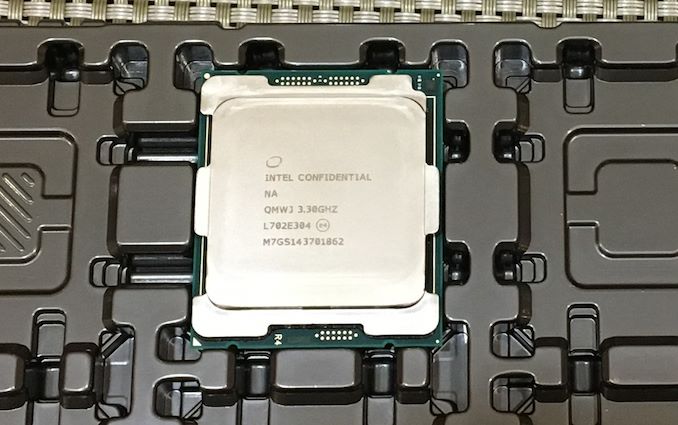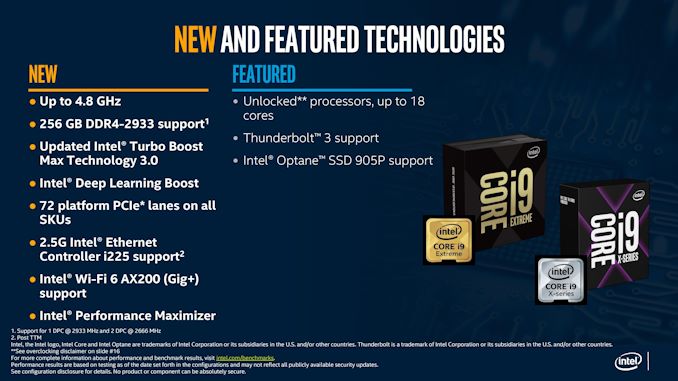Intel's Cascade Lake-X CPU for High-End Desktops: 18 cores for Under $1000
by Dr. Ian Cutress on October 1, 2019 6:35 PM EST- Posted in
- CPUs
- Intel
- HEDT
- LGA2066
- Cascade Lake

With someone in the press having broken their embargo earlier today, Intel is lifting the lid earlier than planned on their upcoming Cascade Lake-X family of processors for the high-end desktop (HEDT) market. Similar to the way Intel's Cascade Lake based Xeon Scalable processors are a further revision of their Skylake Xeons, offering clock speed increases and security fixes in hardware, the new HEDT processors will grant higher frequencies, more memory capacity, and better protection against side-channel attacks. The key numbers however are the big drop in Intel's pricing: Intel will be releasing its 18-core part, the Core i9-10980XE, for under $1000.
| Intel Cascade Lake-X | |||||||
| AnandTech | Cores Threads |
Base | All Core |
TB2 | TB3 | TDP | Price (1ku) |
| Core i9-10980XE | 18C / 36T | 3.0 | 3.8 | 4.6 | 4.8 | 165 W | $979 |
| Core i9-10940X | 14C / 28T | 3.3 | 4.1 | 4.6 | 4.8 | 165 W | $784 |
| Core i9-10920X | 12C / 24T | 3.5 | 4.3 | 4.6 | 4.8 | 165 W | $689 |
| Core i9-10900X | 10C / 20T | 3.7 | 4.3 | 4.5 | 4.7 | 165 W | $590 |
| Skylake-X (previous generation) | |||||||
| Core i9-9980XE | 18C / 36T | 3.0 | 4.5 | 4.7 | 165 W | $1979 | |
| Core i9-9940X | 14C / 28C | 3.3 | 4.5 | 165 W | $1387 | ||
| Core i9-9920X | 12C / 24T | 3.5 | 4.5 | 165 W | $1189 | ||
| Core i9-9900X | 10C / 20T | 3.5 | 4.5 | 165 W | $989 | ||
This pricing is a significant shift in Intel's strategy, and a number of fingers will be pointed at AMD as having made this happen. Next month AMD is set to launch its 16-core Ryzen 9 3950X at $749, which will offer 16 PCIe 4.0 lanes for slots (+4 for M.2, +4 for chipset) and support for 128 GB of DRAM. So Intel needed something similarly speedy, but with more PCIe lanes and more memory support that they could offer for just a bit more, leading to the 10980XE for $979. Ultimately, the on-shelf price is often just slightly higher than tray price, so don't be surprised if retail prices land at around $1000.
All the CPUs will support 256 GB of quad-channel memory (up from 128 GB), and have 48 PCIe 3.0 lanes (up from 44). Memory speed support is listed as DDR4-2933 for 1 DIMM per channel, and DDR4-2666 for 2 DIMMs per channel. All these CPUs have a TDP of 165 W, which Intel states will help the CPUs to turbo longer under Intel's recommended settings (as we know, consumer motherboard manufacturers like to ignore these anyway). All these CPUs are supported in X299 motherboards.
There is no 16-core in this stack, with Intel's official reasoning being that they assess the market with each generation and they don't believe there's a suitable price point for such a part when the 14C and 18C parts are so close. Most people will point the finger and say that no-16 core Intel part means no direct comparison with the Ryzen 9 3950X, which is something to think about.
Another point to note is that Intel has stopped this stack at the 10 core and no lower. This means that there will be no cross over between Intel's consumer processor stack and the HEDT stack, with users needing to spend just a little bit more from the Core i9-9900K/KF to reach up to the Core i9-10900X. It will be interesting to see where Intel's Core i9-9900KS fits in, although that still only has dual channel memory and 16 PCIe 3.0 lanes.
Intel lists Wi-Fi 6 and 2.5GbE support on these new processors - to clarify, Intel means external controllers here. For some odd reason when Intel says support, it could mean internal to the chipset or external via a controller; this is messaging I've railed against for a while, as it ends up confusing for enthusiasts, especially when this is an enthusiast platform. It does mean however that we get official information about Intel's 2.5GbE controllers, which we've been waiting on for a couple of years. Intel stated that these controllers will be ready at a later date, and more information to follow. (The controllers are currently listed on Intel's ARK database, but as 1 GbE controllers for some reason.)
These CPUs will have the same security mitigations as the Cascade Lake Xeon processors, with updated hardware mitigations for a number of side channel attacks. We are waiting to hear from Intel if the firmware that supports these processors will also have additional fixes in for Zombieload by default.
One question about this launch is surrounding Intel’s 14nm capacity. Within the last week, there have been reports that despite Intel’s best efforts and promises to match demand, and that Q3 and upcoming for Q4 is going to be busier than expected. We reached out to Intel last week for clarification, and the company said that the bulk of its capacity is focusing on the high-end processors in the market: the Xeon Scalable, the Core i9, Core i7, and Core i5. It will be interesting to see if launching another family of products is going to put additional strain on Intel’s capacity and demand.
With AMD's recent Zen 2 Ryzen 3000 series launch on 7nm earlier in the year, Threadripper 3 coming later this year, and Intel swinging another generation of 14++ into the high-end desktop market, Intel is going to have some tough times. Don't get me wrong, this pricing update from Intel is a good thing for users, especially those looking at implementing things like DL Boost to their workflow, but this market is suddenly turning very aggressive, and it will be interesting to see if Intel can be agile enough to keep pace.
Intel's Cascade Lake-X processors will be available in November. More details should be released nearer to launch.











162 Comments
View All Comments
Spunjji - Wednesday, October 2, 2019 - link
Everything you're referencing in your first sentence happened after Intel successfully staved off competition with its predatory pricing schemes.You couldn't get a Dell system with an AMD chip in it throughout the Athlon 64 / OG Opteron era despite the obvious superiority of the AMD chips, and it was entirely because Intel bribed Dell (and others) to buy from them alone. AMD's subsequent poor decision making has nothing to do with that.
Enthusiasts of that era are also aware that AMD charged more for their chips when they had a definitive performance lead - that isn't news. They'll probably do it again with Zen 3 if Intel haven't caught up by then.
The_Assimilator - Wednesday, October 2, 2019 - link
You gotta let go of the past, man.Korguz - Wednesday, October 2, 2019 - link
" You are conveniently ignoring plenty of idiocies on AMD side " intel has had its own, and as spunjji mentioned, it cost intel a billion or so in a settlement to AMD, seems you are conveniently ignoring that." Also Intel had always massive margins thanks to vertical integration" BS, its also be cause they were over charging for their cpus, look at the prices for the 9900 series vs 109xx series.
" People forget that for some years during Pentium 4 era AMD was more expensive then Intel " yes. because the performance was there. just like intel has been doing for the last 5 or so years.
azfacea - Thursday, October 3, 2019 - link
"Intel used all kind of scammy tactics" of course they did. because they had Fab volume that allowed them to do that. They can't do that to TSMC.has nothing to do predatory pricing
Father Time - Monday, October 21, 2019 - link
Intel was found guilty in court and made to pay AMD for their illegal practices. You can't argue this.It was predatory pricing - Intel would offer incentives to not offer any AMD alternatives, and as Intel was the market leader with name recognition, even companies as big as Dell were unable to do anything about it - if they dared to offer AMD systems, they would lose the Intel kick-backs and no longer be able to compete on price for Intel systems.
At the time AMD had the better tech, and was slowly clawing market share, but Intel was a household name and no major company could afford to bet their entire business on AMD and give up completely on their Intel lineup.
imaheadcase - Wednesday, October 2, 2019 - link
Its not really competition thought, because that is also suppose to bring forth innovation which is not really happening as well. DIfferent prices, boost core and a AMD chips that was planned years ago.eek2121 - Wednesday, October 2, 2019 - link
Indeed, only consumers win here. Regarding PCIE: People forget how to count. It's also PCIE 4.0 vs PCIE 3.0. This actually means that the regular Ryzen chips have more PCIE bandwidth than HEDT Intel chips. An embarassment for Intel.techguymaxc - Tuesday, October 1, 2019 - link
This is a solid lineup. X299 owners withA) lower core count CPUs
B) need for higher clocks
C) need for more RAM
May find this upgrade path compelling.
Personally, as a 7960x owner I’m less tempted by this upgrade path and will wait to see what Threadripper 3000 offers. If AMD will sell me 64 cores with decent all-core clocks at a price that doesn’t require a second mortgage, that’s going to be hard to beat.
kobblestown - Wednesday, October 2, 2019 - link
Well, about the RAM situation - the new CPUs do not offer more channels or slots. It's just that intel has removed the artificial limitation and can now use 32GB DIMMs. Compare this to the ThreadRippers which support 1TB from the very beginning. Sure, we'll never have 128GB UDIMM DDR4 modules with which to implement it but at least we are not butt fu...d by the manufacturer for no apparent reason!BTW, I'm pretty sure that the initial TR 3xxx lineup will not include 64 core chip. There's no need for it. A 24 core TR 3 will wipe the floor with anything intel has to offer. Including their 28 core joke of a room heater.
techguymaxc - Wednesday, October 2, 2019 - link
I haven't seen a Threadripper motherboard claim > 256GB RAM support yet. Are you sure about this?I disagree about the 28-core i9 - AVX workloads still run best on Intel, and clockspeed still matters. That being said, a 64-core Threadripper would absolutely beat this chip and hence why I am interested. I agree it is unlikely that a 64-core chip will join the ranks of Threadripper 3000 chips at launch, but I hope it will arrive eventually at a price I can justify.